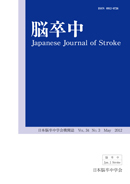31 巻, 6 号
選択された号の論文の34件中1~34を表示しています
- |<
- <
- 1
- >
- >|
第34 回日本脳卒中学会講演
<会長講演>
総説
-
2009 年31 巻6 号 p. 395-403
発行日: 2009/11/25
公開日: 2009/12/15
PDF形式でダウンロード (776K)
<理事長講演>
-
2009 年31 巻6 号 p. 404-409
発行日: 2009/11/25
公開日: 2009/12/15
PDF形式でダウンロード (334K)
<シンポジウム>(日本脳卒中学会・日本脳卒中の外科学会)(S1-A-01~S1-A-08)脳卒中の先端治療研究─臨床への道─
総説
-
2009 年31 巻6 号 p. 410-414
発行日: 2009/11/25
公開日: 2009/12/15
PDF形式でダウンロード (369K) -
2009 年31 巻6 号 p. 415-419
発行日: 2009/11/25
公開日: 2009/12/15
PDF形式でダウンロード (310K) -
2009 年31 巻6 号 p. 420-424
発行日: 2009/11/25
公開日: 2009/12/15
PDF形式でダウンロード (294K)
原著
-
2009 年31 巻6 号 p. 425-432
発行日: 2009/11/25
公開日: 2009/12/15
PDF形式でダウンロード (432K) -
2009 年31 巻6 号 p. 433-438
発行日: 2009/11/25
公開日: 2009/12/15
PDF形式でダウンロード (388K)
<シンポジウム>(日本脳卒中学会・日本脳卒中の外科学会)(S1-A-09~S1-A-14)大規模臨床研究の現状
総説
-
2009 年31 巻6 号 p. 439-442
発行日: 2009/11/25
公開日: 2009/12/15
PDF形式でダウンロード (204K) -
2009 年31 巻6 号 p. 443-447
発行日: 2009/11/25
公開日: 2009/12/15
PDF形式でダウンロード (309K)
<シンポジウム>(日本脳卒中学会・日本脳卒中の外科学会)(S2-A-00~S2-A-06)脳卒中と高次脳機能障害
総説
-
2009 年31 巻6 号 p. 448-452
発行日: 2009/11/25
公開日: 2009/12/15
PDF形式でダウンロード (272K)
原著
-
2009 年31 巻6 号 p. 453-457
発行日: 2009/11/25
公開日: 2009/12/15
PDF形式でダウンロード (335K)
<シンポジウム>(日本脳卒中学会・日本脳卒中の外科学会)(S2-A-11~S2-A-17)Stroke team,SCU の現状と課題
総説
-
2009 年31 巻6 号 p. 458-460
発行日: 2009/11/25
公開日: 2009/12/15
PDF形式でダウンロード (266K)
原著
-
2009 年31 巻6 号 p. 461-466
発行日: 2009/11/25
公開日: 2009/12/15
PDF形式でダウンロード (326K)
総説
-
2009 年31 巻6 号 p. 467-471
発行日: 2009/11/25
公開日: 2009/12/15
PDF形式でダウンロード (280K)
<シンポジウム>(日本脳卒中学会・日本脳卒中の外科学会)(S3-A-08~S3-A-13)脳卒中画像診断の最先端
総説
-
2009 年31 巻6 号 p. 472-476
発行日: 2009/11/25
公開日: 2009/12/15
PDF形式でダウンロード (352K) -
2009 年31 巻6 号 p. 477-482
発行日: 2009/11/25
公開日: 2009/12/15
PDF形式でダウンロード (388K)
原著
-
2009 年31 巻6 号 p. 483-490
発行日: 2009/11/25
公開日: 2009/12/15
PDF形式でダウンロード (441K)
<シンポジウム>(日本脳卒中学会・日本脳卒中の外科学会)(S3-A-14~S3-A-20)脳卒中リハビリテーションと地域連携パス
総説
-
2009 年31 巻6 号 p. 491-496
発行日: 2009/11/25
公開日: 2009/12/15
PDF形式でダウンロード (468K) -
2009 年31 巻6 号 p. 497-501
発行日: 2009/11/25
公開日: 2009/12/15
PDF形式でダウンロード (338K)
原著
-
2009 年31 巻6 号 p. 502-507
発行日: 2009/11/25
公開日: 2009/12/15
PDF形式でダウンロード (597K)
総説
-
2009 年31 巻6 号 p. 508-514
発行日: 2009/11/25
公開日: 2009/12/15
PDF形式でダウンロード (648K)
原著
-
2009 年31 巻6 号 p. 515-520
発行日: 2009/11/25
公開日: 2009/12/15
PDF形式でダウンロード (381K)
総説
-
2009 年31 巻6 号 p. 521-530
発行日: 2009/11/25
公開日: 2009/12/15
PDF形式でダウンロード (732K)
<シンポジウム>(日本脳卒中学会・日本脳卒中の外科学会)(S2-B-09~S2-B-14)脳動脈閉塞性疾患の病態と治療
総説
-
2009 年31 巻6 号 p. 531-537
発行日: 2009/11/25
公開日: 2009/12/15
PDF形式でダウンロード (361K)
原著
-
2009 年31 巻6 号 p. 538-543
発行日: 2009/11/25
公開日: 2009/12/15
PDF形式でダウンロード (409K) -
2009 年31 巻6 号 p. 544-549
発行日: 2009/11/25
公開日: 2009/12/15
PDF形式でダウンロード (359K)
総説
-
2009 年31 巻6 号 p. 550-553
発行日: 2009/11/25
公開日: 2009/12/15
PDF形式でダウンロード (301K)
<シンポジウム>(日本脳卒中学会・日本高血圧学会・日本腎臓学会合同)(S1-B-01~S1-B-04)脳卒中予防と高血圧,腎障害(CKD)
総説
-
2009 年31 巻6 号 p. 554-558
発行日: 2009/11/25
公開日: 2009/12/15
PDF形式でダウンロード (442K)
原著
-
2009 年31 巻6 号 p. 559-563
発行日: 2009/11/25
公開日: 2009/12/15
PDF形式でダウンロード (267K) -
2009 年31 巻6 号 p. 564-569
発行日: 2009/11/25
公開日: 2009/12/15
PDF形式でダウンロード (402K)
総説
-
2009 年31 巻6 号 p. 570-574
発行日: 2009/11/25
公開日: 2009/12/15
PDF形式でダウンロード (330K)
<シンポジウム>(日本脳卒中学会・日本血栓止血学会合同)(S2-A-07~S2-A-10)脳卒中の一次・二次予防のエビデンス
総説
-
2009 年31 巻6 号 p. 575-579
発行日: 2009/11/25
公開日: 2009/12/15
PDF形式でダウンロード (271K) -
2009 年31 巻6 号 p. 580-585
発行日: 2009/11/25
公開日: 2009/12/15
PDF形式でダウンロード (436K)
「脳梗塞t-PA 研究会」 第3 回研究集会
<短報>
-
2009 年31 巻6 号 p. 586-589
発行日: 2009/11/25
公開日: 2009/12/15
PDF形式でダウンロード (373K)
- |<
- <
- 1
- >
- >|
